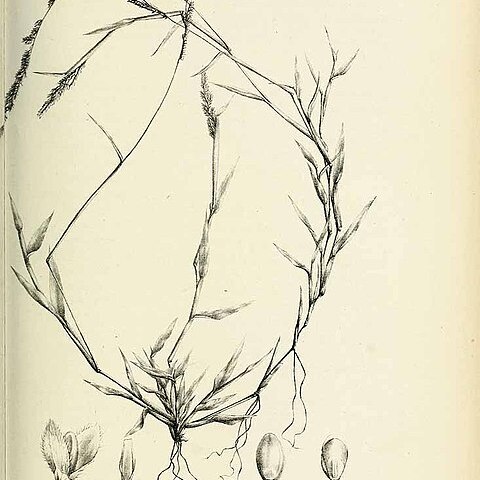Loosely tufted annual 100-500(-1000) mm high; culm erect, decumbent, sometimes straggly or procumbent and rooting at the nodes. Leaf blade 20-150 x 2-6 mm; ligule a fringe of hairs. Inflorescence of 10-25(-30) mm long racemes, secund; rachis less than 1 mm wide, solid, triquetrous or crescentic, sometimes narrowly winged; spikelets covering the whole length of the rachis and arranged in two rows; pedicels of equal lengths. Spikelet 1.7-2.7 mm long, sparsely hairy (rarely glabrous), hairs short (up to 0.5 mm long); lower glume up to 1/5 as long as spikelet, not separated from upper glume by an internode, 1-nerved or nerveless; lower lemma acute or rounded; upper lemma readily deciduous, obtuse, smooth, shiny; palea rounded at apex; anther 0.9-1.1 mm long.
Annual. Culms loosely tufted, slender, much branched, geniculately ascending, 30–40 cm tall, nodes softly hairy. Leaf sheaths glabrous or loosely tuberculate-hairy; leaf blades linear-lanceolate, 1.5–10.5 × 0.3–0.6 cm, glabrous or pilose; ligule ciliate. Inflorescence axis 3–6 cm; racemes 4–10, 1–3 cm, erect or narrowly ascending; rachis narrow, triquetrous, ciliate or scabrous; spikelets single, in 2 rows, overlapping. Spikelets elliptic, 1.8–3 mm, pilose, subacute; lower glume 0.2–0.3 mm, membranous, glabrous; upper glume and lower lemma as long as spikelet, 5-veined; upper floret readily deciduous, oblong, ca. 1.5 mm, thinly crustaceous, smooth, glossy, apex obtuse. Fl. and fr. summer–autumn. 2n = 18.
Loosely tufted annual; culms 10–60 cm. high, slender, geniculately ascending.. Leaf-blades linear to narrowly lanceolate, 2–15 cm. long, 2–6 mm. wide, glabrous or pubescent.. Inflorescence of 3–14 racemes on an axis 1–8 cm. long; racemes 0.5–2.5 cm. long, secund, bearing single spikelets imbricate on a triquetrous rhachis.. Spikelets elliptic, 1.7–2.7 mm. long, pubescent (rarely glabrous or villous), subacute; lower glume a tiny scale 0.2–0.5 mm. long (up to 1/5 the length of the spikelet); upper lemma readily deciduous, smooth, shiny, obtuse.
Annual; up to 0.5 m high; loosely tufted; sometimes straggly or procumbent. Culms erect or decumbent and rooting at nodes. Leaf blades 20-150 x 2-6 mm. Flowers: inflorescence subdigitate; racemes secund; 10-25(-30) mm long; pedicels equal; spikelets 1.7-2.7 mm long; in 2 rows; sparsely pilose; not distinctly flattened.
Annual, loosely tufted (sometimes straggly or procumbent), up to 500 mm tall. Leaf blades 20-150 mm long, 2-6 mm wide. Culms erect or decumbent and rooting at nodes. Spikelets 1.7-2.7 mm long. Racemes secund, 10-25(-30) mm long; spikelets sparsely pilose, arranged in 2 rows, pedicels equal.
Inflorescence of 3–14 racemes, these 0.5–2.5 cm. long, bearing single spikelets on a triquetrous rhachis, sometimes with a secondary racemlet at the base.
Superior floret readily deciduous, its lemma smooth, shiny and obtuse.
Spikelets 1.7–3 mm. long, pubescent (very rarely glabrous), subacute.
Inferior glume a tiny scale up to 1/5 length of spikelet.
Culms 10–60 cm. high, geniculately ascending.
Loosely tufted annual.


